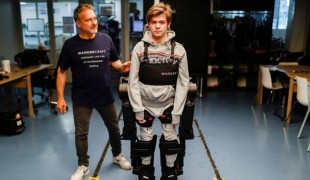- 10371
- 701
- 18
- 25
- 0
- Help Ukraine
About the solution
Jon Christiansen was a sea captain. In 1985 he was hired to sail a replica of the Godspeed.
One day while he was cleaning the ship's hull, someone spun the wheel, trapping Christiansen's leg between the rudder and a support post. The accident severed or damaged most of the nerves below his left knee. Doctors told him he would never have feeling in his left foot again.
Christiansen had the strength to walk with a cane, but without feeling in his foot, he could not know when each step hit the ground without looking down. After a painful fall in 2003, he recruited two friends, engineers Richard Haselhurst and Steve Willens, to help him find a better way to get around. Willens came up with the idea of using tones to signal Christiansen's brain when his foot touched the ground, and in 2006 the three built a prototype of Sensastep.
"I was stepping off a gangway, and just went straight down," Christiansen explains. "So my wife said, 'We've gotta come up with something that tells you where your foot is.' "
To use Sensastep, the patient wears a conductive foam insole embedded with 13 pressure sensors. As the heel or toe strikes the ground, a transmitter strapped to the ankle sends signals to a receiver that's slipped over the ear. The earpiece vibrates against the bone behind the ear, stimulating the cochlear nerve. Variations in the vibrations, which the patient perceives as audible tones, alert the brain to which part of the foot has contacted the ground. Christiansen and other patients will not need to look down and watch every step they take to avoid falls anymore.
Sensastep could help patients with sensory and motor-skill disabilities caused by diabetic neuropathy or Parkinson's disease, as well as those with balance problems from strokes or injuries. Compared with other assisted walking devices, it will be convenient: the insole fits in any shoe, and the ankle and earpiece charge like a cellphone. The inventors have also developed an app to track patients' improvement.
"It's basically like a jumper cable between where a foot should be, and the brain," Christiansen said. "I can almost feel my foot — my brain thinks it can feel where my foot is," he said.
The device is small and relatively unnoticeable. It only requires 30 minutes of use before your brain can recall the tone pattern on its own. Then you can discard the device for the rest of the day.
Adapted from: http://bit.ly/2haCDS6
More info: http://sensastep.com/
https://www.youtube.com/watch?v=8njcTahm1oE
这些解决方案不应包括使用药物,化学品或生物制品(包括食品);创伤性设备;冒犯性的,商业或内在危险的内容。该解决方案未经医学验证。请谨慎进行!如果您有任何疑问,请咨询健康专家。
DISCLAIMER: This story was written by someone who is not the author of the solution, therefore please be advised that, although it was written with the utmost respect for the innovation and the innovator, there can be some incorrect statements. If you find any errors please contact the patient Innovation team via info@patient-innovation.com
-
-
340
-
0
-
4192

Collaborator Pierluigi Mantovani creates Evolution Devices - solutions that aim to transform Multiple Sclerosis Management
CAREGIVING
BODY BALANCE: Maintaining body balance
STANDING UP: Standing up from a seated position
WALKING: Walking
Multiple Sclerosis
Assistive Daily Life Device (to help ADL)
Walking Aid (wheelchair/walker/crutches)
App (Including when connected with wearable)
AI algorithm
Body-Worn solutions (Clothing, accessories, shoes, sensors...)
Restoring mobility
Regaining sensory function
Managing pain
Promoting self-management
Preserving Organ Function
Managing Neurological Disorders
Maintaining Balance and Mobility
To improve Treatment/Therapy
Preventing (Vaccination, Protection, Falls, Research/Mapping)
Raise awareness
Caregiving Support
General and Family Medicine
Internal Medicine
Medical Genetics
Neurology
Physical Medicine and Rehabilitation
United States
-
-
-
1007
-
9
-
27621

母亲发明了设备帮助他的儿子再次走路
WALKING: Walking
WALKING WITH A WALKING AID: Walking with a walking aid
Cerebral Palsy
Assistive Daily Life Device (to help ADL)
Body-Worn solutions (Clothing, accessories, shoes, sensors...)
Walking Aid (wheelchair/walker/crutches)
Impaired movement
Restoring mobility
Managing Neurological Disorders
Maintaining Balance and Mobility
Caregiving Support
Neurology
Pediatrics
Physical Medicine and Rehabilitation
Israel
-
-
-
398
-
0
-
5532

Father creates exoskeleton to help son with genetic neurological condition walk
BODY BALANCE: Maintaining body balance
STANDING UP: Standing up from a seated position
WALKING WITH A WALKING AID: Walking with a walking aid
CAREGIVING
Cervical spinal cord injury/Tetraplegia
Assistive Technology access
Walking Aid (wheelchair/walker/crutches)
Restoring mobility
Managing pain
Promoting self-management
Preserving Organ Function
Managing Neurological Disorders
Recovering from Traumatic Injuries
Maintaining Balance and Mobility
Restoring Blood Circulation
To improve Treatment/Therapy
Preventing (Vaccination, Protection, Falls, Research/Mapping)
Raise awareness
Caregiving Support
General and Family Medicine
Intensive Care Medicine
Neurology
Physical Medicine and Rehabilitation
Sports Medicine
France
-
 zh
zh